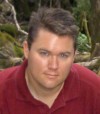How did I get here?
I have been thinking about water for a long time. My father probably had the most profound impact on my interest in earth sciences through his passion for the outdoors and rock collecting. When I was 7 or 8 years old, I was honing my civil engineering skills with my brother as we built a “mud city” in the backyard. Growing up outside of Portland Oregon meant that it rained almost all the time. So, our city made of mud came complete with underground storm drains, bridges, and a river running through it. My interest in exploration was sparked around age 10 (1980), as NASA’s voyager space probes sent back stunning images of the outer planets and the space shuttle program was planning its maiden voyage. I wrote letters to all the NASA space centers asking for their latest technical briefs and pictures, and I built space shuttle models for school projects. Between 10 and 14 years old, I was highly involved in Boy Scouts, being a young patrol leader and taking on the challenge of teaching my peers how to tie the 6 basic knots. In the pre-GPS era, one of the most important outdoor skills was orienteering (using a map and compass to navigate from point to point). For fun on weekends, I would get some friends together on bicycles to find benchmarks (brass survey markers set in stone or concrete) that were marked on geological maps. We would often end up high on mountain tops clearing away brush to find these long-forgotten relics.
In 8th grade (13 years old) my school offered an opportunity to participate in a career day – where you could take the day off from school and spend it following around a professional. My interests in the outdoors, orienteering and science pointed me towards geology as a possible career day choice. So, I arranged to spend the day at the U.S. Geological Survey (USGS). It turns out that the USGS office in Portland Oregon is part of their water resources division, and is primarily focused on hydrologic sciences. They suggested that water might actually be an interesting career choice related to geology. I agreed, and decided to be a hydrologist at 13 years old. From there, I worked for several summers at the USGS, supporting a study of water quality in the Yakima River Basin (Central Washington State).
My dream was to go to school in Northern California, but when I asked my USGS colleagues where the best place to study water was, they pointed me to the University of Arizona in Tucson. I applied, and was immediately accepted in 1988 with a great scholarship. I earned my B.S. in Hydrology and water resources in 1992. I skipped the Master’s degree, and earned a Ph.D. in Hydrology and Water Resources at the University of Arizona in 1996. During my university years I had some wonderful experiences working at Los Alamos National Laboratory developing landfill cover technology, working in Globe Arizona studying the permeability of volcanic tuff, developing some of the first eddy covariance systems, and developing a real love for field observations, modeling and data assimilation.
When I graduated in 1996, I found myself coming full-circle back to my childhood interest in space. I was offered a research science job at NASA’s Goddard Space Flight Center, studying water from space. I quickly build a number of new research programs, such as the Land Data Assimilation Systems, and the Land Information System. I also helped to establish a new soil moisture mission (Hydros – now SMAP), and helped to get several more hydrologic missions to measure surface water and snow started. I served as a program manager at NASA Headquarters, as a Branch Head at Goddard, and mentored a plethora of interns each summer. In 2005 I was offered a faculty position at George Mason University, and my love for teaching drew me to the new challenge.
My George Mason faculty position only supports about 1/3 of my salary, so I have become quite an entrepreneur – starting and building non-profit and commercial companies, working with NGO’s, writing government grants, and advising federal government water programs. My current interests are to advance land modeling and data assimilation, develop the next generation water cycle observation satellite, to lead NASA’s Energy and water Cycle Program (NEWS), and to develop and promote the North American Water Program (NAWP).
It has been a strange and wonderful journey, and I am looking forward to the next chapter.
